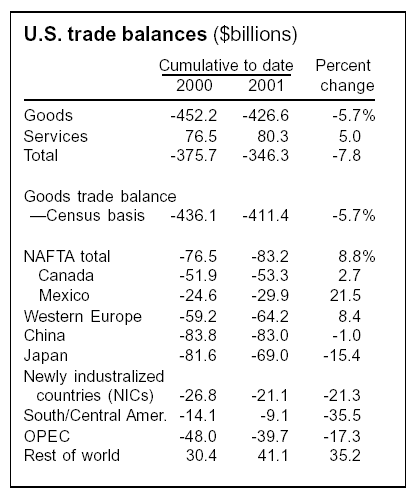February 21, 2002
Trade deficit remains high despite recession
The U.S. Department of Commerce today reported that the merchandise trade deficit fell to $426.6 billion in 2001, a decline of only 5.7%. The aggregate U.S. trade deficit, which includes both goods and services trade, was $346.3 billion in 2001, 7.8% less than in 2000. This drop in the deficit, however, is a result of U.S. economic weakness, not improvements in U.S. competitiveness.
The merchandise deficit as a share of U.S. gross domestic product (GDP) remained above 4% for the second year in a row. The merchandise deficit closely tracks the broadest measure of U.S. international transactions, the current account, data for which will not be released until next month.
The trade deficit poses great risks for the U.S. economy. When the economy eventually begins to recover, this deficit is likely to grow rapidly. Since the U.S. must borrow from abroad to finance these deficits, at some point foreign lenders are likely to slow the supply of new credit, pushing the U.S. economy into a sharp recession, a deep devaluation of the dollar, or both (see EPI’s report Fast Track to Trade Deficits). The risks of collapse grow rapidly when the trade deficit exceeds 5% of GDP.
The U.S. economy is overly dependent on imports, and permanent trade deficits are built into the structure of the economy. The steep trade deficit results from foreign barriers to U.S. exports, unfair dumping of imports in the U.S., and a run-up in the U.S. dollar, which has gained 27% in real value since 1995. Structural difficulties with trade agreements, such as the lack of labor standards, are also part of the problem.
Reduced demand for U.S. exports also contributed to the trade deficit in 2001. Japan, Canada, Mexico, and most of Europe are also in recession or experiencing economic slowdowns. The global slowdown has been underway since at least 2000, yet the Bush Administration and other G-7 governments have failed to stimulate their economies in a coordinated fashion.

U.S. trade deficits with Mexico increased 21.5% in 2001, and reached record levels despite the overall decline in the U.S. trade deficit. Key U.S. imports from Mexico included motor vehicles and parts, petroleum, electronic products, and telecommunication equipment, which was primarily assembled in the Maquiladora export-processing zones. U.S. trade deficits with Western Europe and Canada also increased in 2001, by 8.4% and 2.7%, respectively.
China continues to have the largest bilateral trade deficit with the U.S. of any country in the world. The 1.0% decline in the U.S. trade deficit with China in 2001 masks deeper underlying changes in the structure of U.S. trade with Asia and the rest of the world. U.S. trade deficits with Japan and the newly industrializing countries (Hong Kong, Singapore, South Korea, and Taiwan) fell 15.4% and 21.3%, respectively. In addition, U.S. trade deficits with South/Central America and with the OPEC countries also fell significantly, in part as a result of falling oil and gas prices.
The manufacturing sector lost 1.3 million jobs in 2001, and 1.9 million manufacturing jobs have been eliminated since April 1998. Rapid growth in the trade deficit between 1998 and 2000 was responsible for the initial round of job losses in manufacturing. These losses deepened in 2001 because of the U.S. recession and continued growth in productivity, which is strongly associated with intense import competition.
-by Robert E. Scott
The Economic Policy Institute TRADE PICTURE is published upon the release of quarterly and year-end trade figures from the Commerce Department.
EPI offers same-day analysis of income, price, employment, and other economic data released by U.S. government agencies. For more information, contact EPI at 202-775-8810.
